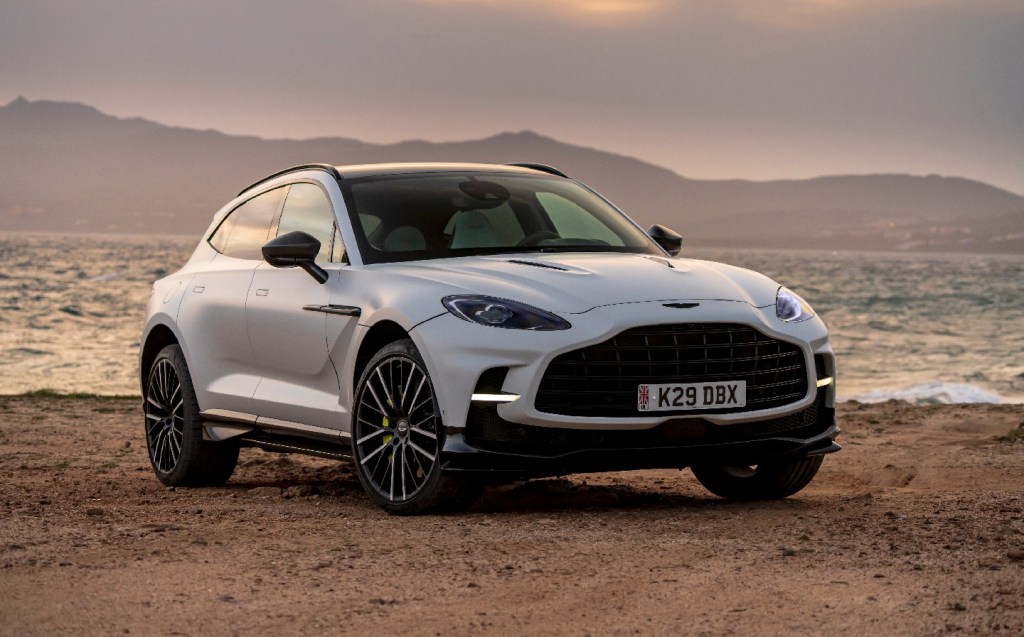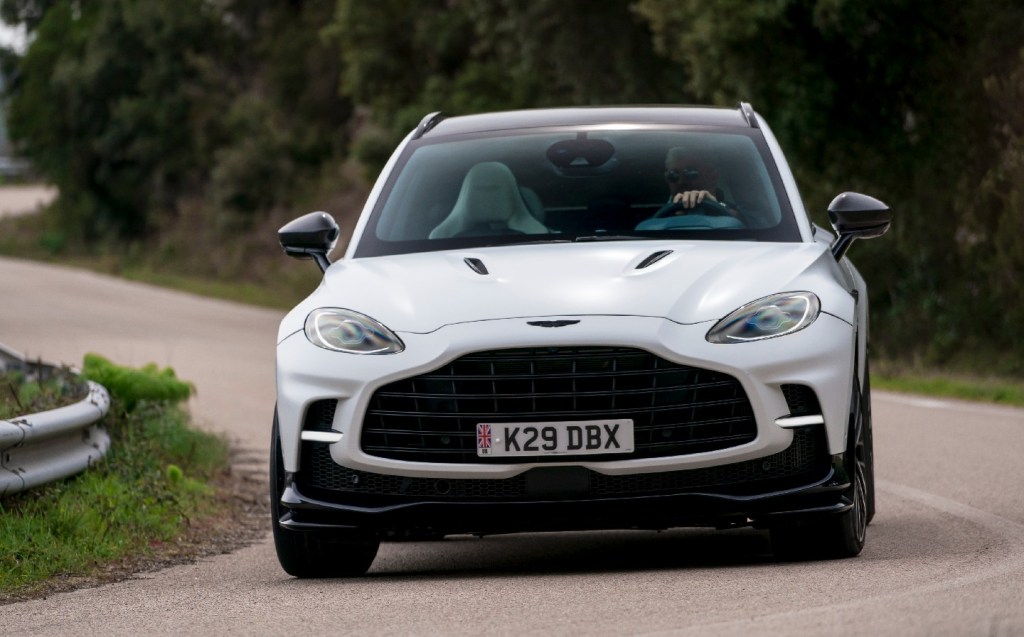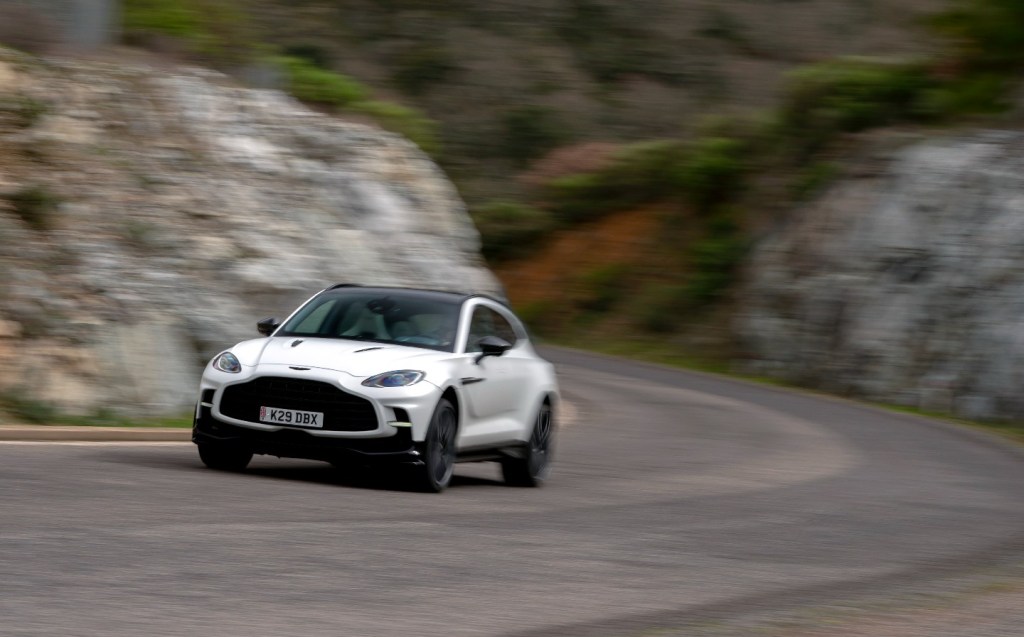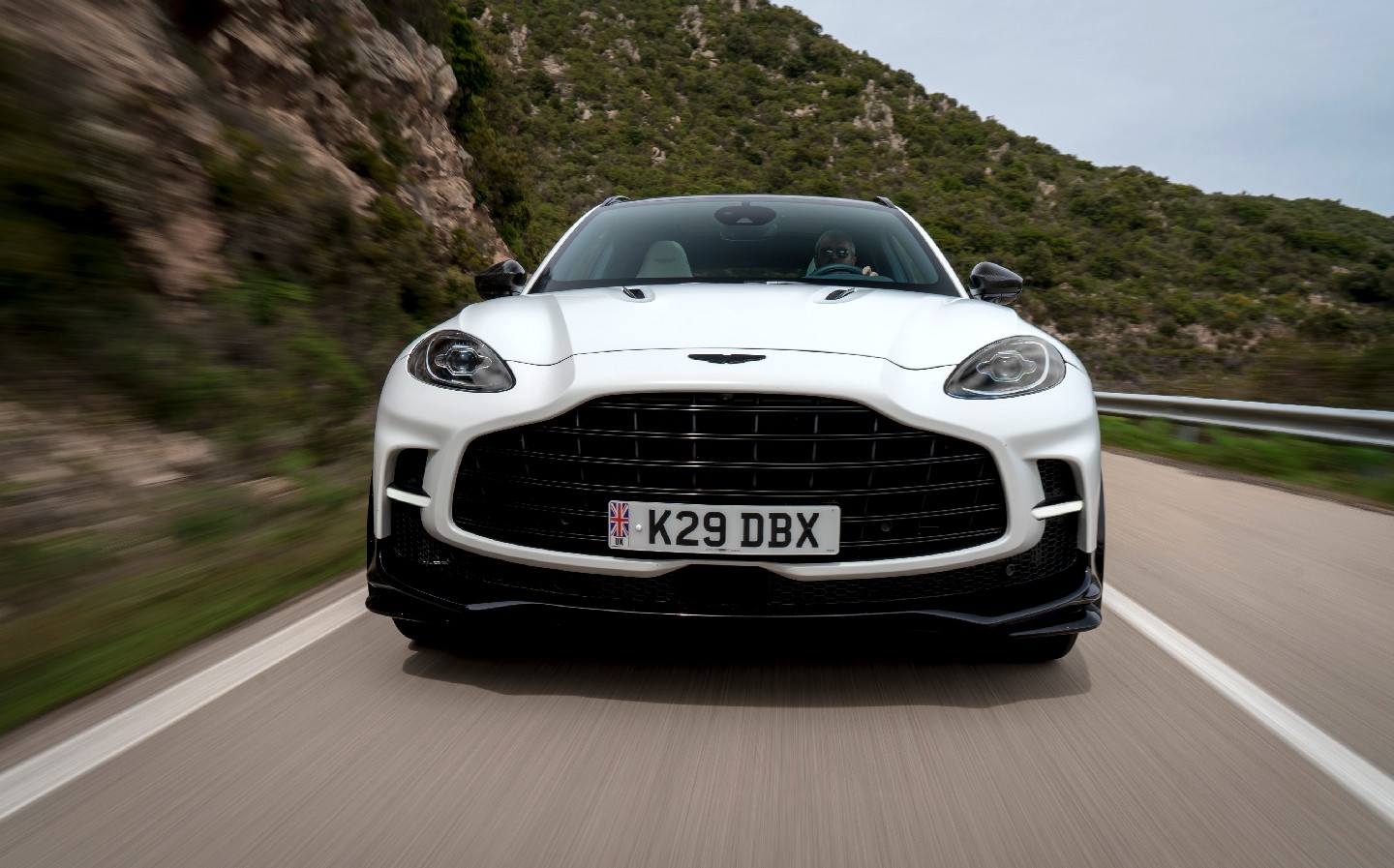Aston Martin DBX707 2022 review: The new fastest luxury SUV in the world is about more than just power
Suck on my quad exhausts, Lamborghini
Is it okay to get excited about a 697bhp V8-powered hulking-great SUV? In these days of electrification, limited road space and record high petrol prices, it might put one in the minority. But bloody hell, the Aston Martin DBX707 is such an extraordinary piece of physics-defying machinery that it deserves our attention.
Besides, only 3,001 DBXs found homes globally over the last 12 months, so it’s unlikely the more powerful DBX707, which is expected to make up 60-65% of the model’s sales in future, will have a major impact on the polar ice caps. Not in the global scheme of things.
But why does it exist at all? We know why the DBX was created — SUVs are profitable and sell better than sports cars. The DBX is as important to Aston Martin as the Cayenne was to Porsche, and could be equally vital in ensuring the brand’s survival. Aston sells more DBXs than all the other models combined.
The hot DBX707, though? Look no further than the Lamborghini Urus, which outguns the regular 535bhp Aston Martin DBX to the tune of 106 brake horsepower, and hits 60mph from standstill nearly a second quicker. It also costs at least £10,000 more. In a world on one-upmanship, if you have the money the Urus is the SUV to add to the collection.
Aston’s woes were enhanced when Porsche created the Cayenne Turbo GT, a 631bhp track-focused super-SUV, then took it to the Nurburgring and set a new record for SUVs.
So this is the British firm hitting back with what it unabashedly declares is the world’s most powerful luxury SUV. DBX707 has a 0-60mph time 0.3sec quicker than the Urus and eyes set on stealing the Nordschleife lap record from its German rival (so a little birdy tells us).
Of course, that means the Aston Martin DBX707 is about more than just more power under the bonnet. Read on for the full review.
Exterior design

Check out the size of that grille — the biggest Aston Martin has ever produced. The shark nose effect is enhanced by angling the grille backwards more, which makes the car look longer at the front (it isn’t).
Arguably the bigger grille is as much a status symbol as an improved means of cooling the V8 engine and carbon ceramic brakes. Its size is emphasised by a monster front splitter, along with new horizontal daytime running lights, which designer Marek Reichman said were intended to make the front look wider and more planted to the floor.
There are also new black trim elements at the front of the wheel arches, which help improve airflow around the wheels, and this wider, lower look is continued along the sides with black sills and another shark fin element in front of the rear wheels.

The back of the car is a little wider than the regular DBX, with the rear wheels pushed further apart, and the black trim elements and quad exhausts, along with an enlarged carbon-fibre double diffuser, help improve the wider visual stance.
How well that diffuser pushes the DBX707 to the ground at speed is questionable, given how high off the floor it sits, but combined with the new spoiler on top of the boot lid there is bound to be an effect, especially approaching the 197mph top speed.

But from an aesthetic point of view, at least, the DBX707 is a more arresting and, dare I say it, attractive interpretation of the DBX formula, particularly when sitting on the optional 23in alloy wheels (22in are standard).
Interior and technology
The inside of the DBX has always been a bit of a mixed bag. On our DBX707 test car, gone was the odd raised leather stitching on the dashboard (which Jeremy Clarkson described, not without merit, as like “botched plastic surgery”).

Choosing this type of dashboard is an option, and a great start on making the interior a much better place to be, but there’s so much more you can change through both the regular configurator and the company’s bespoke service, Q by Aston Martin. Go through them and almost anything is possible – for a price.
In fact, at the car’s launch Reichmann said he guaranteed no two cars would leave the factory with the same specification, such is the level of individualisation available via Q by Aston Martin.
But by default the Mercedes parts bin infotainment system and its rotary dial / touchpad control remains. What you’d expect to be a touchscreen is actually not touch sensitive at all, and that’s disappointing. Okay, touchscreens can be distracting but they don’t have to be – the best ones allow very quick and easy access to menus and submenus. In the DBX, the rotary dial is much less intuitive, in fact, as even simple tasks like switching from 2D to 3D view on the navigation are virtually unfathomable.
If you were being kind you’d say Aston’s gone for the “old money” effect, but in reality it suggests Mercedes hasn’t allowed Aston to use its newest touchscreens, and that makes the DBX’s infotainment feel second-rate.
The voice control is also a bit outdated now, as it’s not as smart as some other systems which use AI to better understand your requests. For example, you can’t say “Play Times Radio”, you have to specify “Station: Times Radio”. First World problems, maybe, but this is an Aston Martin, not a Fiat.
And if you prefer Samsungs to iPhones, you’re bang out of luck when it comes to Android Auto — as with the regular DBX, only Apple CarPlay is available.

However, the DBX707’s cabin overall is a good place to be. The DBX707’s 16-way electrically-adjustable heated sports seats — covered in leather as standard — are not the same as those in the regular DBX, and they’re brilliantly supportive as well as comfortable. The steering wheel is electrically adjustable, too, and finding the perfect driving position is simple, whatever your height.
As with the DBX, the Mercedes-derived switchgear is a little oddly laid out, with the heated steering wheel and screen wash controls hidden away on the end of steering column stalks, but once you know where they are they’re easy to operate.
It’s also easier to find the driver-focused settings on the 707, with a redesigned centre console now containing a Drive Mode dial and individual buttons for electronic stability and suspension, making it quicker to switch between modes — or switch off the nannying aids — on the fly.
And I do like the DBX’s individual buttons for Drive, Park and Engine Start on the centre of the dashboard, which is a nice point of differentiation, as well as the cushioned door hinges and the way the electric windows slide up and down almost silently, with a silky-smooth action.
There’s acres of space in the rear, and a sizeable boot, too — nothing is lost in terms of capacity when compared with the regular DBX. But a lot is gained in terms of performance.
Engine and performance

The heart of the car is the Mercedes-AMG-derived twin turbo V8. It’s the same fundamental engine as the regular DBX but engine chief Ralph Illenberger, who moved from AMG to Aston when his old boss Tobias Moers took over as CEO, squeezed 697bhp (707ps, hence the name) out of the same unit by introducing all-new turbochargers — the fastest-spooling in the world, no less.
No Mercedes featuring this powerplant can boast that much power — even in the Mercedes-AMG GT 63 S it produces “only” 630bhp, and on the torque front, not even the mighty Mercedes-AMG G63 can compete with the DBX707’s 664 lb ft.
Torque is so strong, in fact, that the carbon fibre prop shaft has been shortened and thickened, and a nine-speed wet clutch transmission has been introduced. Aside from being able to withstand the increased forces, the wet clutch also means super-smooth and super-quick (40% faster) shifts.
Combined with new closer gear ratios, four-wheel drive, a new limited-slip rear e-differential and new electronic launch profile, 0-62mph takes just 3.3 seconds using the launch control system. DBX707 will also hit 100mph from standstill in 7.4sec and go on to 193mph, which makes it a full 3mph faster than the Urus. In your face, Lamborghini.
Ride and handling

As mentioned at the start, the DBX707 is about more than a power hike; almost everything to do with the ride and handling has been updated.
The e-diff on the rear helps the car rotate easier into and out of corners, while a re-calibrated centre differential allows and yaw angle sensor allow almost all the power to go to the rear wheels and keep it there — not that we tested this on the narrow Sardinian mountain passes.
What’s very noticeable, though, is the astonishing grip on twisty roads. You can’t avoid the fact that this is a car that has a high centre of gravity and weighs 2.25 tons, so understeer is possible when pushing hard through a turn but, assuming you’re not four-wheel drifting everywhere, lifting off the throttle mid-corner allows the car to pivot nicely.
The balance is astonishingly good — Aston was at pains to point out the 52:48 front-to-rear weight distribution versus 58:42 for the Urus and Cayenne GT — and the feel through the wheel is also a step up from the standard DBX thanks to increased stiffness of the front subframe and lighter carbon ceramic brakes (reducing unsprung mass), plus dialling back of electronic assistance in the steering rack.

Perhaps the biggest revelation is the way the suspension has been reworked in collaboration with the drive modes.
This is a car that, weirdly, you can drive everywhere in Sport+, because there’s no immediate stiffening of the dampers to give the “impression” of sportiness — it’s only when you combine Sport and Sport+ modes with exaggerated steering and throttle inputs that you feel a difference in the car’s damping and stability systems; they react a lot quicker to keep the car stable and planted to the road.
Revisions to software and hardware (new stiffer top mounts and hydro instead of elastomer bushes, if you must know) further reduce shockwaves over broken road surfaces when compared with the regular DBX, making the DBX707 a brilliantly usable everyday road car — the ride is even smoother than the regular DBX, which was already notable for its excellent ride quality.

And as with the steering, the amount of roll allowed has been tuned for greater driving pleasure, rather than simply made faster or stiffer. There’s about 50% more roll torque than before but Aston has left in some lean to allow a more linear, progressive feel to the handling. In practice, that makes the 707 a delight to steer along interesting B-roads and mountain passes. It’s no lightweight sports car, but it’s fun.
Pricing, on-sale date and availability
The base price of the Aston Martin DBX707 is around £190,000, which is £22,000 more than the base DBX, but with every buyer speccing their model individually, each car will vary in cost enormously, particularly if going through the bespoke service, Q by Aston Martin.
They will do pretty much anything for a price, though if you were thinking of fitting a V12, that may be a challenge – something to do with limited space in the engine bay due to the long suspension travel.
Similarly, it’s on sale now and deliveries are scheduled to begin in Q2 of this year, but expect time to be added on if you’re asking for anything especially unique.
But in terms of availability, this isn’t a limited edition model so expect orders to be honoured even if you need a bit more time to think about it.
Verdict: 2022 Aston Martin DBX707 review

Aston Martin reckons 60-65% of DBX sales will be DBX707 from now on, and after driving it I’d say this might be an underestimate; if you can afford a DBX you can almost certainly afford a DBX707, and as the latter improves on the core car in every conceivable way, there’s almost no reason not to stretch the budget.
Buyers will find that not only is the handling and sporting nature of the car ramped up when driving hard, but at cruising speed the ride quality and refinement is improved, too. This is the ultimate version of the DBX, and perhaps one of the best all-round SUVs yet created.
But I won’t be putting my order in until Aston adds Android Auto.
Tweet to @wdron Follow @wdronRelated articles
- If you enjoyed this 2022 Aston Martin DBX707 review, you may also be interested in Mr JWW’s bespoke Aston Martin DBX featuring Valkyrie paint and a bespoke badge
- Did you know that Aston Martin quadrupled revenue on the back of its success with the DBX
- And don’t miss this story about Aston Martin eyeing further electrification with its Britishvolt battery agreement
Latest articles
- Lewis Hamilton wants to design a modern day Ferrari F40 with manual gearbox

- Dacia Bigster 2025 review: The ‘anti-premium’ family SUV that punches above its weight

- Your car’s worn tyres could be being burnt illegally in India, investigation reveals

- Open-top 214mph Aston Martin Vanquish Volante is world’s fastest blow-dry

- F1 2025 calendar and race reports: The new Formula One season as it happens























